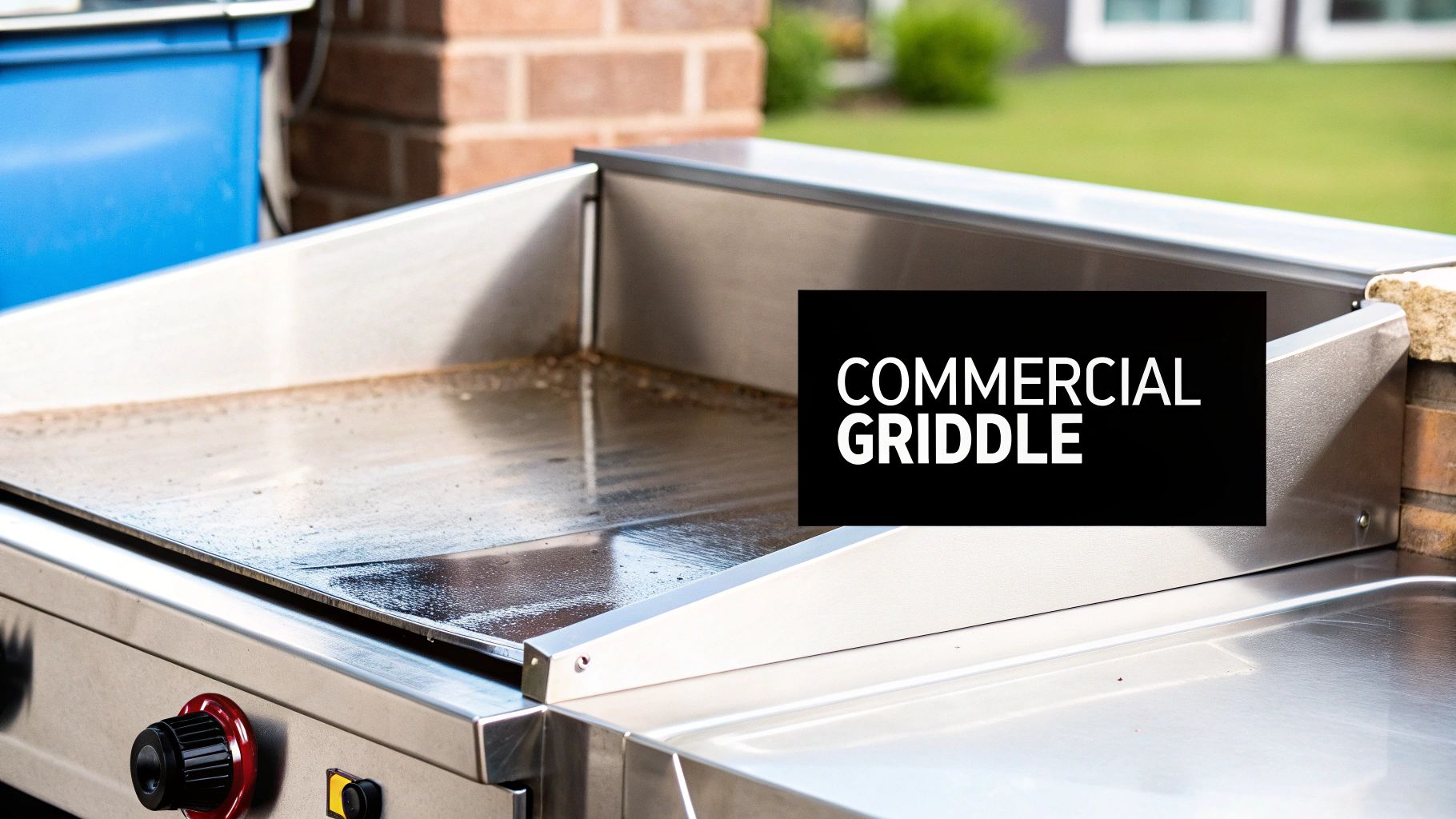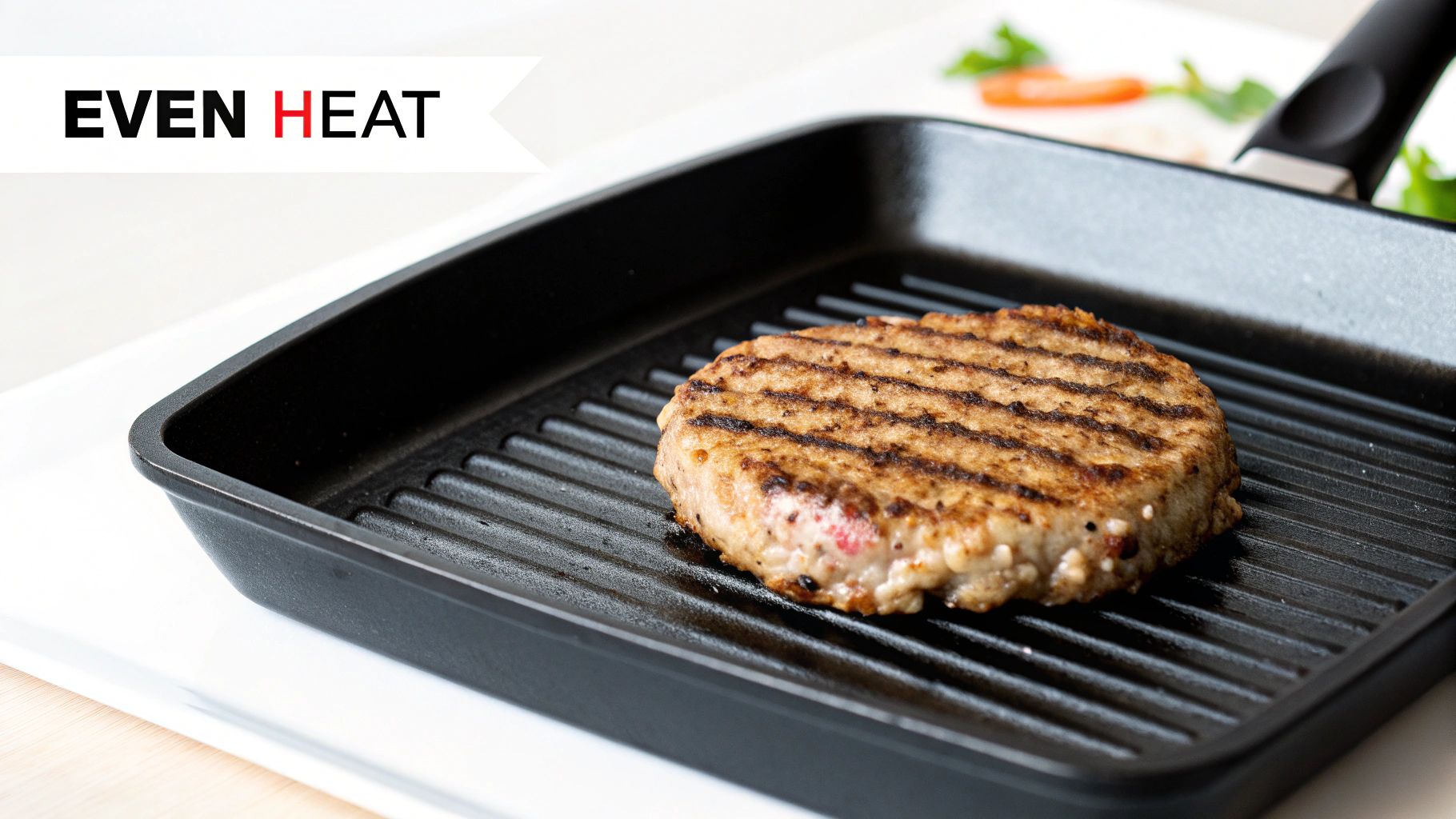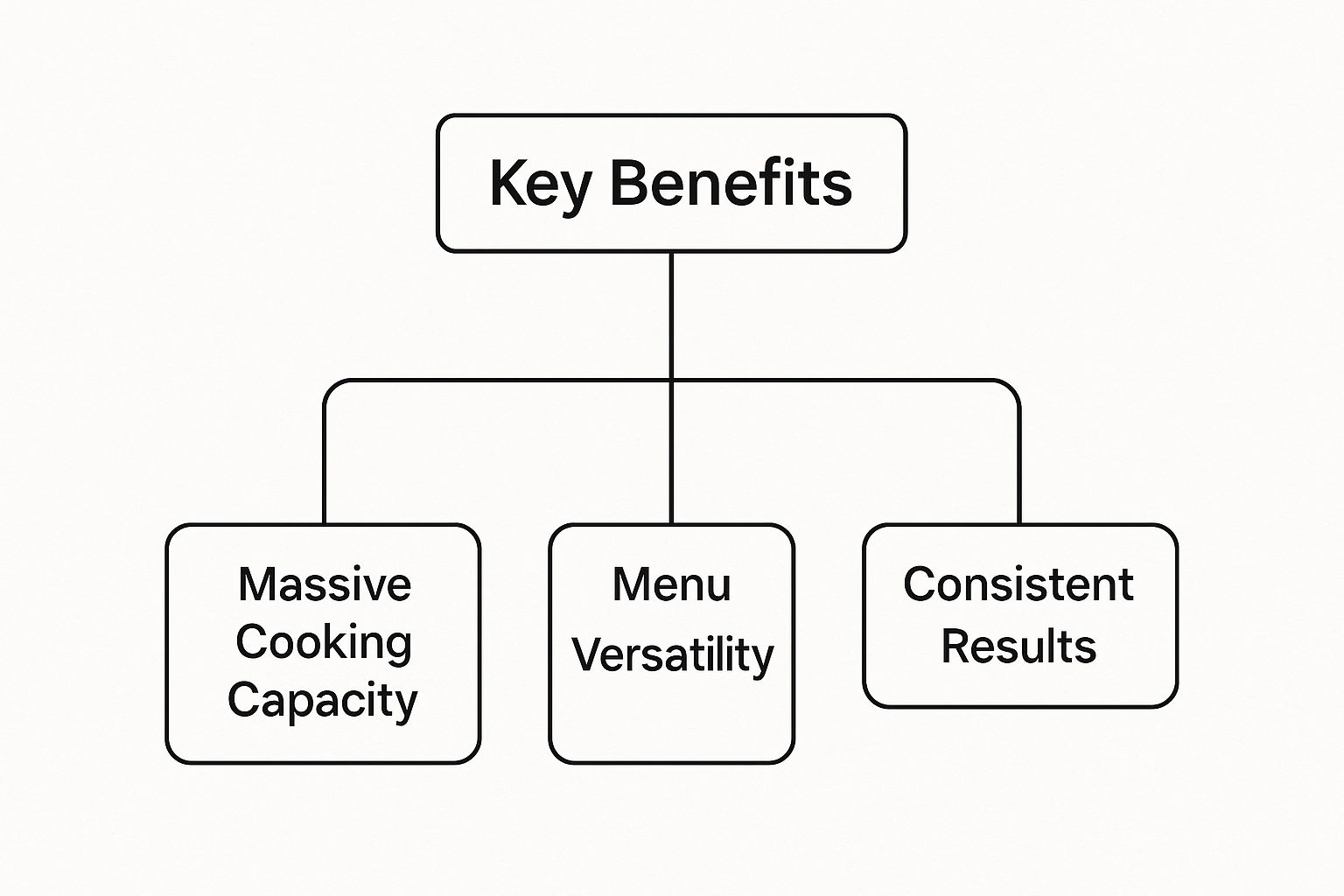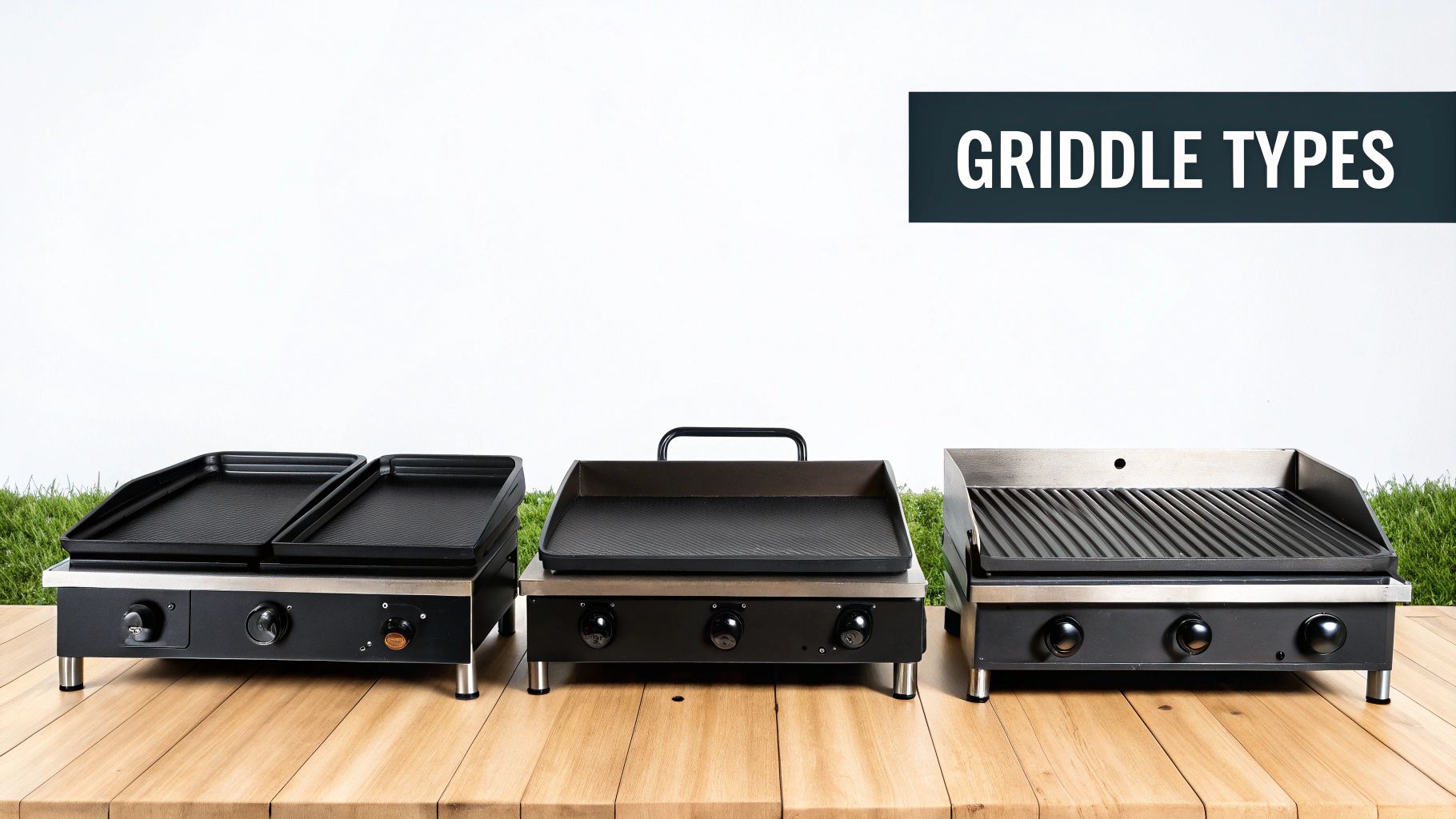
The Ultimate Guide to Commercial Griddles for Your Kitchen
Walk into any bustling professional kitchen, and you'll see it: the commercial griddle. It's the undisputed workhorse of the line, handling everything from the morning breakfast rush to the late-night dinner service. This isn't just a big flat-top; it's a precision tool built for two things: high-volume output and rock-solid consistency. It's the secret to making sure every single pancake, burger, and cheesesteak that leaves the kitchen is cooked perfectly.

The Foundation of Kitchen Versatility
A commercial griddle is the ultimate multitasker. It’s engineered to pump out steady, even heat across a massive cooking surface. Forget the hot spots and uneven cooking you get with a standard frying pan. A professional griddle holds its temperature, allowing a line cook to juggle multiple orders at once without breaking a sweat. It's what makes the whole operation possible in diners, food trucks, and busy restaurants where you can't sacrifice speed or quality.
At its core, the job is simple: transfer heat evenly and efficiently. But that simple job opens up a world of possibilities, letting you sear, toast, warm, and sauté all on the same surface.
Gas Versus Electric Models
One of the first forks in the road when choosing a griddle is the power source. Each has its own personality and is suited for different kitchen workflows and menus.
- Gas Griddles: These are the classic choice for chefs who live and die by responsiveness. Gas models heat up fast and let you make temperature adjustments in a flash. That instant control is perfect for a dynamic menu where you’re jumping from a hard sear on a steak to gently warming buns moments later.
- Electric Griddles: If precision is the name of the game, electric is your player. These griddles are champs at locking in a specific temperature and holding it steady across the entire surface. This makes them unbeatable for delicate items like eggs or crêpes, where even a slight temperature swing can ruin the dish.
Think of a thick griddle plate as a thermal battery. It soaks up and stores a ton of heat. So, when you drop a dozen cold burger patties on it, the temperature barely flinches. You get a perfect, consistent sear every single time.
Figuring out whether you need the raw power of gas or the fine-tuned control of electric is the first real step in picking the right griddle. It's a decision that will directly shape how your kitchen runs, influencing everything from food quality to ticket times. This choice is the foundation for everything else that makes these cooking surfaces so effective.
How Commercial Griddles Deliver Perfect Results

So, what's the magic behind a commercial griddle's ability to pump out perfectly cooked food time after time? It all starts with the griddle plate. This isn't just a sheet of metal; it's a seriously thick, heavy slab of steel, chrome, or a composite material built for one job: soaking up, holding on to, and spreading out a massive amount of heat.
Think of that plate like a giant heat battery. Its sheer mass, a principle we call thermal mass, allows it to maintain a rock-solid temperature across the entire surface. This is what kills the dreaded "hot spots" you find in regular pans, meaning a burger on the corner cooks just as fast and evenly as one in the dead center.
This is exactly why a commercial griddle doesn't flinch under pressure. When your line cook throws down a dozen frozen patties, the temperature barely dips, recovering almost instantly to deliver that consistent, beautiful sear. That reliability is the bedrock of any high-volume kitchen.
The Brains Behind the Brawn: Control Systems
If the griddle plate is the muscle, the control system is the brain telling it what to do. Picking the right control type for your menu is a huge deal, and it mostly comes down to two choices: thermostatic or manual.
Each one has its place, and knowing the difference will help you match the machine to your kitchen's flow.
- Thermostatic Controls: Think of these as the precision option. You dial in a specific temperature, say 350°F, and an internal thermostat kicks the burners on and off to hold that exact temp. This is non-negotiable for delicate items like pancakes, eggs, or fish where a few degrees can make or break the dish.
- Manual Controls: These are all about raw power and direct control, usually with simple low, medium, and high settings. The heat is continuous, giving the chef maximum energy transfer. It's the go-to for tasks that need a ton of heat, like getting a hard sear on steaks or making classic smash burgers.
A well-engineered griddle plate ensures that the temperature you set is the temperature you get, everywhere on the surface. It’s the difference between guessing and knowing, which is critical during a busy service when consistency is non-negotiable.
The Importance of a Seasoned Surface
Beyond the hardware, the cooking surface itself is a critical part of the equation. For traditional steel griddles, the process of seasoning is everything. By polymerizing layers of oil, you build up a natural, slick non-stick coating.
This seasoned layer does more than just prevent food from sticking; it also protects the steel plate from rust and even adds to the unique flavor you can only get from a well-loved flattop. For anyone bringing in a new unit, learning how to season a new griddle is job number one.
When you bring it all together—a high-mass plate, a responsive control system, and a perfectly seasoned surface—you get more than just a piece of equipment. You get the powerful, reliable engine of the commercial kitchen, ready to deliver flawless results with every single order.
Key Benefits of Using a Commercial Griddle
A commercial griddle is far more than just a big slab of hot metal; it’s the engine that drives productivity in a busy kitchen. Adding one of these workhorses to your lineup brings real, measurable benefits that touch everything from kitchen efficiency and menu variety to your final profit margin.
These advantages aren't accidental. They're baked right into the griddle's design, which is built from the ground up to handle high-pressure, high-volume cooking environments. Once you understand these core strengths, it becomes obvious why this one piece of equipment is often the most valuable real estate on the line.
This graphic breaks down the main advantages a commercial griddle brings to the table.

As you can see, the core benefits—capacity, versatility, and consistency—all work together, creating a powerful foundation for just about any successful foodservice operation.
Massive Cooking Capacity
The first thing you’ll notice about a commercial griddle is its sheer size. A standard 48-inch model gives a chef a massive cooking area, big enough to juggle dozens of items at the same time. Picture a classic diner during the Sunday morning rush. A single cook can have pancakes, eggs, bacon, and hash browns going for multiple tables, all on one surface.
This high-volume capability is a total game-changer for ticket times. Instead of a line cook playing Tetris with a bunch of small pans on a range, everything is happening in one organized space. This cranks up the kitchen's output, helps turn tables faster, and ultimately boosts revenue during your busiest hours.
Incredible Menu Versatility
A griddle is no one-trick pony. That huge, flat surface is one of the most flexible tools a chef has. In the morning, it's your breakfast station. Come lunchtime, it’s flipping burgers, searing cheesesteaks, and grilling sandwiches. For the dinner crowd, it can put a perfect sear on a steak, sauté vegetables, or toast buns.
This adaptability is a lifesaver, especially in tight quarters like a food truck. A food truck operator can run their entire menu off a single griddle, searing off high-end steak one minute and grilling quesadillas the next. This flexibility lets a business follow customer tastes without having to buy a bunch of different, specialized appliances.
A commercial griddle often becomes the central hub of the production line. Its ability to handle so many different cooking tasks means less running around for the chef, a smoother workflow, and a calmer, more organized kitchen.
Consistent and Repeatable Results
Consistency is what separates the pros from the amateurs, and a griddle is built to deliver it every time. The thick, heavy griddle plate is fantastic at holding and spreading heat evenly, which gets rid of the hot and cold spots that ruin food cooked in regular pans.
This means every single burger gets the same beautiful crust, and every pancake is cooked to a perfect, even golden brown. Think about a restaurant famous for its smash burgers. They rely on their griddle to deliver that signature crust and texture on every patty, every single day. That kind of repeatability is what builds a great reputation and keeps customers coming back for more.
To make things even better, modern grease management systems and easy-to-clean surfaces make the kitchen safer and cut down on closing time, saving you real money on labor.
Comparing Types of Commercial Griddles

Picking the right commercial griddle isn't a one-size-fits-all deal. It’s really about matching the gear to your kitchen's space, menu, and the way your team works. Whether you need a compact unit to add some extra cooking power or a massive, dedicated griddle station, your choice will have a huge impact on your kitchen’s daily rhythm. Getting a handle on the core differences is the first step to finding that perfect fit.
The most common models you'll see are countertop griddles. Think of these as the versatile workhorses for smaller kitchens, food trucks, and busy cafes. They pack a serious punch in a small package, giving you a high-capacity cooking surface without needing a full kitchen renovation. This makes them a fantastic option for anyone looking to add grilled items to their menu without giving up precious counter space.
Griddle Plate Materials and Thickness
The real heart of any griddle is its cooking surface—the plate. The material it's made from and its thickness are what really dictate how it's going to perform. Different plates are built for different jobs.
-
Standard Steel Plates: There's a reason these are the industry standard. A thick steel plate, usually between 3/4-inch to 1-inch thick, is a beast when it comes to holding and spreading heat. This makes it perfect for high-volume cooking, like slapping down frozen burger patties or getting a hard sear on a steak. That thick steel acts like a heat battery, so the temperature doesn't plummet the second cold food hits it.
-
Polished Chrome Surfaces: Got more delicate items on the menu? A chrome-plated griddle might be your best friend. The surface is incredibly smooth and non-porous, which means less sticking. It's ideal for things like eggs, pancakes, and flaky fish. As a bonus, it radiates less heat into the kitchen, which your staff will definitely appreciate. Just remember to use non-metal utensils to avoid scratching that beautiful finish.
A thick steel plate is the secret behind a perfect smash burger. Its ability to maintain intense, even heat ensures that signature crust forms instantly, locking in juices for a consistently delicious product every time.
The Power Source Gas vs Electric
Choosing between a gas or electric griddle often comes down to what your kitchen is set up for and what your chefs prefer.
Gas models heat up fast and let you make quick temperature changes on the fly, a responsiveness many chefs swear by. They're the classic choice for that high-energy, seat-of-your-pants cooking where you need instant control.
Electric griddles, on the other hand, offer amazingly precise and steady temperature control. This makes them some of the most consistent griddles you can get for flat-top work, holding an exact temperature across the entire surface without hot spots. Picking a fuel type is a big decision, and you can dive deeper into the comparison of natural gas vs propane griddles to figure out which is right for you.
How to Choose the Right Griddle for Your Business
Picking the right commercial griddle is a big deal. Let’s be honest, this thing is going to be the workhorse of your kitchen. It has a direct impact on your food quality, how fast plates get to the window, and even how stressed your cooks are during a rush. You need to look at your menu, your kitchen layout, and your busiest service times to find the perfect fit.
The first step is looking at what you actually cook. Are you a diner slinging delicate pancakes and eggs all morning, or a burger joint that needs a serious, aggressive sear? The answer will point you toward the right griddle surface, whether that’s a slick chrome top for non-stick cooking or a thick slab of steel that holds heat like a champ.
Calculating Your Required Griddle Size
Once you know what’s on the menu, you need to figure out how much of it you'll be cooking. Sizing your griddle isn’t a guessing game—it's about planning for your absolute busiest hour. A good rule of thumb is to calculate the maximum number of griddled items you sell during that peak and make sure you have the flat-top real estate to handle it.
A griddle that’s too small will instantly create a bottleneck. Tickets will back up, and you’ll have frustrated cooks and hungry customers. On the flip side, a griddle that’s too big is just burning money on utilities and taking up precious space on the line. For most busy restaurants, a 36-inch or 48-inch model hits that sweet spot between capacity and footprint.
Controls and Features That Drive ROI
The sticker price is just the beginning. Investing in the right features from the start can pay for itself over and over in consistency, efficiency, and safety. One of the biggest decisions you'll make is the type of controls.
Thermostatic controls, for instance, act like cruise control for your griddle, holding a precise temperature automatically. This is a game-changer for getting every pancake that perfect golden-brown or ensuring every burger is cooked to the right temp, which means less food waste and happier customers. We break this down even further in our article on thermostatic vs manual griddle controls.
Investing in a griddle with precise thermostatic controls is like hiring an assistant for your line cook. It manages the temperature so your team can focus on execution, resulting in better food and faster service.
Other features can make or break your daily workflow, too. Keep an eye out for these key elements:
- Plate Thickness: If you’re cooking from frozen—think burger patties or hashbrowns—a 1-inch thick plate is non-negotiable. It recovers heat almost instantly, so the surface temperature doesn’t crash when you load it up.
- Splash Guards: These are a must for containing grease splatter. They keep the surrounding area cleaner and, more importantly, safer for your crew.
- Grease Management: Look for a well-designed grease trough and a large collection tray. Anything that makes cleanup faster saves you serious labor dollars at the end of a long night.
When you carefully weigh your menu, volume, and the daily benefits of these key features, you can find a versatile griddle that will become a reliable, money-making machine in your kitchen for years to come.
Frequently Asked Questions About Commercial Griddles
When you're shelling out for a major piece of equipment like a commercial griddle, you're going to have some questions. It's a big decision. Getting straight answers on everything from the cooking surface to daily upkeep is the only way to pick a unit that’ll be a reliable workhorse in your kitchen for years.
Let's dive into some of the most common questions we hear from chefs and restaurant owners.
What Is the Difference Between a Steel and a Chrome Griddle Plate?
Think of a standard steel griddle plate as the industry's classic, heavy-duty cast iron skillet. It’s a beast at soaking up heat and holding it, which is exactly what you need for getting a hard, beautiful sear on burgers and steaks. To keep it in top shape, you'll need to season it regularly. This process builds up that perfect, natural non-stick surface over time.
A chrome griddle plate is a different animal entirely. It has a super slick, non-porous top that looks almost like a mirror. This surface is brilliant for delicate foods like eggs and pancakes because they slide right off with hardly any sticking. Chrome is also more energy-efficient since it throws less heat out into the kitchen, which your line cooks will definitely appreciate. The trade-offs? It costs more upfront, and you have to be careful to use non-metal utensils to avoid scratching that pretty finish.
Should I Choose a Gas or an Electric Griddle?
This one usually comes down to what hookups you already have in your kitchen and how you like to cook.
-
Gas griddles are the go-to for chefs who love instant response. They heat up fast and you can crank the temperature up or down in a flash. That speed is a huge advantage in a busy kitchen where you're constantly switching from cooking one thing to the next.
-
Electric griddles are all about precision. They give you incredibly consistent and even heat across every square inch of the cooking surface. For operations where pinpoint temperature accuracy is non-negotiable, they are the most reliable option for consistent flat-top applications.
How Thick Should My Griddle Plate Be?
Griddle plates generally run from a 1/2-inch to a full 1-inch thick. A thinner plate gets hot faster and works just fine if you're only doing light-duty cooking.
But for most busy restaurants, a thicker plate (3/4-inch to 1-inch) is the way to go. It has serious heat retention, meaning its temperature recovers much quicker when you throw a bunch of cold food on it. If you're slinging a lot of frozen burger patties, a 1-inch thick plate is practically a necessity to stop the temperature from crashing and ensure everything cooks evenly.
The secret to a griddle that lasts forever and performs flawlessly is simple: proper maintenance. A little daily cleaning and the right seasoning technique will protect your investment and make sure every plate that leaves your kitchen is top-notch.
How Do I Properly Clean and Season a Steel Griddle?
Taking good care of your griddle is non-negotiable. For daily cleaning, the key is to scrape off all the gunk while the surface is still warm. Use a griddle stone or a tough cleaning pad with a bit of oil to scrub it down, then wipe it clean with a dry cloth.
Seasoning a new griddle (or one you just deep-cleaned) is simple. Heat it up to about 300-350°F, spread a super thin layer of cooking oil across the surface, and let it cook until it stops smoking. That polymerizes the oil and creates that slick, non-stick patina you're looking for. Just remember the two cardinal sins of griddle care: never use harsh soap, and never dump ice on a hot surface—that's a surefire way to warp or even crack the metal.
Ready to find the perfect workhorse for your kitchen? Explore a wide range of professional-grade equipment at Griddles.com, where we offer everything from high-performance griddles to complete kitchen line solutions. Visit https://griddles.com to see our selection and get free, fast shipping on your order.
